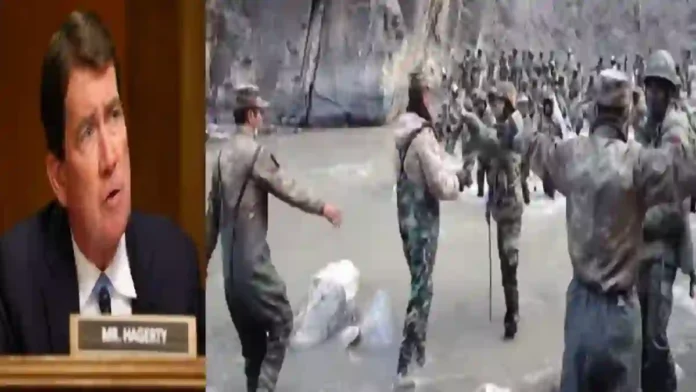US Senator Bill Hagerty’s recent remarks have reignited controversy with a startling and unverified allegation that China used an “electromagnetic weapon” to “melt Indian soldiers” during a border clash with India five years ago, reported Hindustan Times.
Speaking during a discussion on shifting geopolitical equations, Hagerty, a Republican senator from Tennessee, referenced the 2020 Galwan Valley clash without directly naming it, saying that Beijing had deployed a directed-energy capability during the violent confrontation along the Line of Actual Control (LAC).
The bizarre allegation came barely two weeks after Prime Minister Narendra Modi met Chinese President Xi Jinping on the sidelines of the SCO Summit.
His claim, however, lacks corroborating evidence, and no official account from India, China, or independent international observers has ever indicated the use of such non-kinetic weapons during the Galwan incident.
The statement has been described as bizarre and speculative, emerging barely two weeks after Prime Minister Narendra Modi met with Chinese President Xi Jinping on the sidelines of the Shanghai Cooperation Organisation (SCO) Summit in Tianjin, a meeting focused on stabilising relations strained by years of mistrust.
The Galwan clash in June 2020 had marked the lowest point in Sino-Indian relations in more than six decades. A stand-off that began in May along the disputed LAC culminated in a violent hand-to-hand confrontation on June 15 that lasted approximately seven hours.
The fighting, involving improvised melee weapons rather than firearms, led to the deaths of 20 Indian soldiers, including a commanding officer, while China admitted to casualties without giving official figures. Independent assessments and later reports suggested Chinese losses may have exceeded India’s.
Read- Trump Tariffs Threaten To ‘Destroy’ 25 Years of US-India Partnership, Warn Former Diplomats
The incident shocked both nations, as it was the first deadly border clash in 45 years, and it fundamentally shifted the trajectory of bilateral ties. India undertook extensive force deployments and infrastructure upgrades along the frontier in response, while China reinforced its military positions, resulting in an ongoing stalemate.
Against this context, Hagerty’s assertion about “electromagnetic weapons” has drawn sharp attention in Washington and beyond, especially given the rarity of such claims entering mainstream political discourse. Similar allegations were floated in Chinese state-owned media in late 2020, speculating about the People’s Liberation Army (PLA) experimenting with microwave systems to drive Indian troops from contested ridge-lines.
At the time, the reports were widely dismissed as propaganda meant to deter or confuse adversaries, with Indian officials rejecting them and maintaining that casualties came from physical combat in freezing high-altitude conditions, not directed-energy exposure.
Hagerty’s remarks, therefore, appear to revive these earlier rumours but present them in dramatic terms, potentially to underscore his broader argument about China’s aggressive behaviour and shifting alliances in Asia.
His comments come when India-US ties are under renewed strain following a major trade dispute. Former US President Donald Trump recently announced sweeping tariff hikes on Indian exports, imposing a 50 percent levy on Indian goods and an additional 25 percent penalty tied to New Delhi’s purchases of Russian oil.
The decision triggered alarm in New Delhi, raising fears of economic friction at a sensitive time. In recent weeks, however, Trump has attempted to soften his tone by reaffirming his friendship with Prime Minister Modi, stressing that India remains a “very good friend” of Washington despite trade tensions. Modi publicly reciprocated the sentiment, signalling that New Delhi is keen to prevent economic disputes from derailing the larger strategic partnership.
The juxtaposition of Hagerty’s allegation about China with Trump’s trade measures highlights a volatile triangular dynamic among the US, India, and China. For Washington, dramatizing Chinese military tactics serves both a domestic political purpose and a strategic one, reinforcing the narrative of Beijing as a ruthless competitor willing to deploy unconventional means in its disputes.
For India, however, such allegations are a double-edged sword: while they may strengthen arguments about China’s hostile intent, they also revive traumatic memories of the Galwan clash and cast doubt on the credibility of information being circulated by foreign actors without evidence. For Beijing, the claim risks renewing global scrutiny at a time when it seeks to project stability in relations with New Delhi following the high-level SCO interaction.
Hagerty’s sensational assertion about China’s use of electromagnetic weapons during the 2020 Galwan Valley clash is unsubstantiated but politically charged.
Emerging amid trade frictions between India and the US and tentative Sino-Indian rapprochement, it underscores the way past conflicts continue to be leveraged as rhetorical tools in present diplomatic manoeuvring.
While the claim may resonate in certain political circles in Washington, it remains detached from verified accounts of Galwan, serving more as a reflection of geopolitical anxieties than an accurate record of what transpired on the Himalayan battlefront.
Based On Hindustan Times Report
Agency




